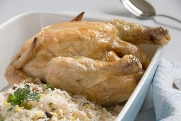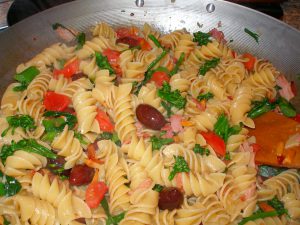By Michal Haines
The classic New Zealand Sunday roast is a tried and true tradition. I recently did a wee poll at work and found, quite to my surprise, the traditional Sunday roast is still going strong.
I would have assumed that in these days of careful healthy eating, huge chunks of roasted meat just weren’t on the menu so much anymore.
The traditional roast didn’t appear often on the kitchen table of my childhood. On the rare occasions it did it was most likely to be chicken, which, to this day remains my favourite roasted meat.
My grandmother on the other hand was a whiz with the roast chicken, wrapping it elegantly in bacon to keep in the moisture, jugs of gravy at the ready to swim those peas in. I remember her chicken so fondly that I am striving constantly to achieve the same taste and tenderness but to no avail. I sometimes wonder if the memory was better than the actuality.
Roasting meats can be a bit haphazard if you don’t stick by some good golden rules. These little things can really be the difference between a dry horrible roast and a fantastic one. Like all cooking it is about learning to achieve the best results. There simply isn’t anything like a good roasted chunk of meat and sure, it is in a different league to a well made curry or an expertly crafted risotto but it still is a thing to rejoice over at the table.
There are a few ways to cook a hunk of meat however.
Low Temperature Roasting
Ranging from 120◦C to 160◦C this ensures less shrinkage of your meat, more even cooking through the meat and certainly more flavour and a more tender result as well as an easier piece of meat to carve. Some chefs even go for a 100◦C for an even longer time making the meat very soft but in no way pink.
High Temperature Roasting
Between 190◦C and 230◦C this is best used to create a crusty exterior and a tender, rare interior.
You can also achieve a crust when low temperature roasting by starting the meat at 200◦C until it has browned and then reducing the temperature back down to the 120-160 range. I am a huge fan of this technique. In theory this sears the meat and holds the moisture in to keep it all nice and juicy in there. It also helps create that fantastic crust that makes the whole enjoyment of a roasted cut of meat just that little bit better. Remember that this initial stage in no way cooks the meat-it just gets thing moving a little quicker.
Tips for Roasting
Take the meat from the fridge half an hour prior to roasting to at least bring it partially back to room temperature. This will help the cooking speed as the heat will move through the flesh quicker.
Cuts are important. Selecting the correct cut for the right job makes all the difference.
For roasting beef look for the following cuts:
Standing Rib Roast -cut from the rib section of the forequarter, this cut is very juicy and should be well marbled. Sometimes this cut can also be referred to as prime rib roast but be warned this does not indicate a superior quality of meat. Trimming will have been done on the ribs themselves to partially expose them as with a lamb rack. The bone will provide you with extra flavour and then you have the choice to serve it with bone on or off. This cut looks impressive at the table and a whole rib roast of 7 ribs will easily feed up to 14 people.
Sirloin Roast-this cut is taken from the lower middle of the animal’s back .Generally cheaper than whole fillet, this is a great cut that can be cooked easily and feed many. Cooked properly it is fantastic. In its traditional form it would come with bone attached but I certainly have never seen this before. Sirloin can very easily be portioned and seared at high heat as a steak cut also.
Whole fillet roast-this is the whole tenderloin of the animal and will require trimming once you get it home unless a butcher has done that for you. It will cost more per kg but the trimming process can loose up to a kg depending on the size of your fillet so it can sometimes be worth the extra cost, particularly if you are not that great at trimming.
From this whole fillet smaller cuts referred to as filet mignon are created.
Tri Tip Roast-has a similar texture to sirloin. Taking its name from the triangular shape of the cut it is a good slow roasting meat with good texture and flavour.
Shoulder Roast-cut from the forequarter and can come boned or not. Roasting is fine for this cut but can be helped with some extra fat to keep things moist.
For Roasting Pork look for:
Centre and Rolled loin of Pork-Centre pork roast will still have its bones attached where as rolled will have all the bones removed and it will be tied to make it easier to carve. This is a very popular roast and the skin can be salted and scored or dried out to encourage perfect crackling.
Belly- My favourite cut for roasting. Don’t be put off by the fat as without it the meat will be dry. Thin cuts will take little time to roast and by drying the skin out in the fridge uncovered for three days or so you will get fantastic crackling.
For Lamb look for:
Rack of Lamb-Number one for many reasons-easy and fast to cook, delicious, great texture and it has its own handle to make eating easy. No tenderloin makes this a small cut but when well cooked a delicious one. You may also see something that is called a Crown Roast and this is the two racks joined together and formed into a circle to make one large roast.
Loin Roast-can be boned and rolled or complete. A very delicate cut that will need fat to help it along. If boned, it can be stuffed and rolled for extra flavour.
Leg Roast-a classic New Zealand cut that can be butterflied, rolled and boned or roasted complete with bone for extra flavour.
Weight, size and shape
All of these factors play a part in how long your meat will take to cook.
There is no shame in a meat thermometer. They are well priced (usually under ten dollars) and can really be the difference between dry or juicy. They do need at least twenty seconds in the meat to get an accurate reading. Push the skewer in to the thickest area of meat so it is as close to the centre as possible. If you are pushing into bone this can skew the reading slightly but it will be close enough.
Experience goes a long way to being able to just look at a cut and know what cooking time you will need but before that comes practice.
For the most part there are golden rules which have always worked really well for me:
Per 500g red meats need 10 minutes for rare, 15 for pink and 20 for well done
Per 500g pork needs 25 minutes per 500g for well done and 25 for very well done.
Ovens
All ovens are a little tricky. They do behave differently so everything you learnt about your old oven you will have to relearn if you move house or renovate. Pop a thermometer in also to see if your oven is actually reaching the temperature it is telling you it is. If it isn’t getting to 200◦C then you are going to have some issues with roasting.
Basting
This keeps the meat nice and tender. Basting can be done using the fat that will appear in the pan as the meat is cooking.
There seems to be two schools of thought here and I tend to agree with the one that feels that the meat already has a covering of fat so basting shouldn’t be needed. The repeated opening and closing of the oven door will slow things down. The only time that I think it is a must is to achieve crispy chicken skin.
Barding utilises bacon or pancetta-or really any fat-and wraps it about the meat in order to give it more moisture in which to cook. Useful when roasting cuts with little or no fat but remember to remove any barding ten minutes prior to the end of roasting in order to brown the area well.
Resting
Resting is essential. At least fifteen minutes is recommended for the meat to relax enough that when you do make that first cut, it will be juicy and succulent through out. It greatly enhances the meat feel and if you have taken the trouble to cook it well, I am sure you are willing to wait that little bit extra. Fifteen minutes gives the moisture enough time to resettle back into the meat through out the cut, not just at the surface.
Rest meat at warm room temperature or a little higher and avoid any draughts as the meat will go cold. I know a few people who feel that leaving the oven door open and the oven off will be ok for this process but I do feel that the temperature remains far too high and the meat just continues to cook.
The Roasting Tray
The roasting tray itself is an important tool in the success of your roast.
Too large a tray will spread the juices too evenly and allow them to burn quickly. Too small and the meat will be lying about in its own juices stewing away. Pouring fat or excess liquids off during the cooking process can be beneficial if the cut itself is very fatty but otherwise, why loose all that flavour!!
Extras
Seasoning is good but use a little oil or butter to make it stick. The oil will help with the initial high heat cooking stage and the end result will be a little more juicy. Herbs and flavour rubs can be applied but make sure they are done so with oil or butter otherwise they will burn badly before the meat has cooked.
There is a lot here to take in but for the most part it all comes back to the cut itself.
Quality here is all important and why not. If you are going to do little more than rub a little salt and oil into the meat it should be all about that wonderful flavour. Roasting is one of the few times where the meat must really speak for itself. Poor quality meat just won’t stand up to that and you will always be disappointed by the taste. I am not dictating by any means that you should run out and spend you entire budget on one cut of meat for the feast but think more about the quality than the quantity.
Good farming practice produces good meat that will look, smell and taste better when it hits your table. In my mind it doesn’t have to be organic but it does need to have been raised by some one who has taken the time and money to raise the beasts appropriately, has feed them what is natural (certainly no other animals would be an excellent start), and it has be killed in a manner that is both humane and has allowed for the meat to be at its best. I am being very simplistic here and I could lead you further into what would be a rather long rant about ethical farming, production and processing of meat but this is not about that issue. It is a simple fact that you get what you pay for and we all know this. We can’t get around it so if you find a cheap roast cut, I suggest walk away from it. On the whole meat is not cheap and the true test will always be in the eating.




